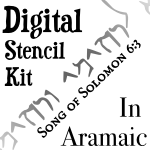By ETHAN BRONNER
Published: July 6, 2008
JERUSALEM — A three-foot-tall tablet with 87 lines of Hebrew that scholars believe dates from the decades just before the birth of Jesus is causing a quiet stir in biblical and archaeological circles, especially because it may speak of a messiah who will rise from the dead after three days.
[…]
It was in Cathedra that Israel Knohl, an iconoclastic professor of Bible studies at Hebrew University in Jerusalem, first heard of the stone, which Ms. Yardeni and Mr. Elitzur dubbed “Gabriel’s Revelation,” also the title of their article.
[…]
In Mr. Knohl’s interpretation, the specific messianic figure embodied on the stone could be a man named Simon who was slain by a commander in the Herodian army, according to the first-century historian Josephus. The writers of the stone’s passages were probably Simon’s followers, Mr. Knohl contends.
[…]
To make his case about the importance of the stone, Mr. Knohl focuses especially on line 80, which begins clearly with the words “L’shloshet yamin,” meaning “in three days.” The next word of the line was deemed partially illegible by Ms. Yardeni and Mr. Elitzur, but Mr. Knohl, who is an expert on the language of the Bible and Talmud, says the word is “hayeh,” or “live” in the imperative. It has an unusual spelling, but it is one in keeping with the era.
Two more hard-to-read words come later, and Mr. Knohl said he believed that he had deciphered them as well, so that the line reads, “In three days you shall live, I, Gabriel, command you.”
To whom is the archangel speaking? The next line says “Sar hasarin,” or prince of princes. Since the Book of Daniel, one of the primary sources for the Gabriel text, speaks of Gabriel and of “a prince of princes,” Mr. Knohl contends that the stone’s writings are about the death of a leader of the Jews who will be resurrected in three days.
[…]
Mr. Knohl said that it was less important whether Simon was the messiah of the stone than the fact that it strongly suggested that a savior who died and rose after three days was an established concept at the time of Jesus. He notes that in the Gospels, Jesus makes numerous predictions of his suffering and New Testament scholars say such predictions must have been written in by later followers because there was no such idea present in his day.
But there was, he said, and “Gabriel’s Revelation” shows it.
“His mission is that he has to be put to death by the Romans to suffer so his blood will be the sign for redemption to come,” Mr. Knohl said. “This is the sign of the son of Joseph. This is the conscious view of Jesus himself. This gives the Last Supper an absolutely different meaning. To shed blood is not for the sins of people but to bring redemption to Israel.”
Read more here:
I’d love to see how things unfold around this artifact, especially if or when they publish high quality photographs or a transcription. Keep your eyes peeled. 🙂
If anyone finds the transcription, I’d also appreciate it if they were to post a link in response to this thread so we can get some discussion going.
Peace,
-Steve



